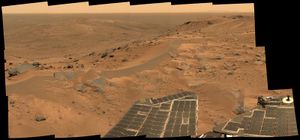Difference between revisions of "Regolith"
m (shorter and better link) |
(Added a table of mineral components.) |
||
| Line 3: | Line 3: | ||
'''Regolith''' is the layer of rocky or icy debris, [[sand]], and [[dust]] made by [[meteorites|meteoritic]] impact that forms the uppermost surface of planets, satellites and asteroids. It is a possible construction material in the form of [[brick]]s. Loose regolith may also be used as a [[radiation]] [[radiation shielding|shield]]. | '''Regolith''' is the layer of rocky or icy debris, [[sand]], and [[dust]] made by [[meteorites|meteoritic]] impact that forms the uppermost surface of planets, satellites and asteroids. It is a possible construction material in the form of [[brick]]s. Loose regolith may also be used as a [[radiation]] [[radiation shielding|shield]]. | ||
| − | Landscapes with regolith formation have been found that look like they were shaped by the flow of water. | + | Landscapes with regolith formation have been found that look like they were shaped by the flow of water. Those formations were probably created by ''"gas-supported density flows"''. |
<ref>How the landscape is formed to the shape of floods: [http://mars.jpl.nasa.gov/mgs/sci/fifthconf99/6005.pdf THE COLLAPSE ORIGIN OF DENSITY FLOWS ON MARS]</ref> | <ref>How the landscape is formed to the shape of floods: [http://mars.jpl.nasa.gov/mgs/sci/fifthconf99/6005.pdf THE COLLAPSE ORIGIN OF DENSITY FLOWS ON MARS]</ref> | ||
| + | |||
| + | == Mineral Composition == | ||
| + | The below table gives estimates of mineral composition based on the soil sample measurements performed by two Mars probes. Only the 6 most abundant minerals are listed. | ||
| + | {| class="wikitable" | ||
| + | |+Estimated abundance (weight %) of main components of Martian soil<ref>Bell JF, McSween HY, Crisp JA, Morris RV, Murchie SL, Bridges NT,...Soderblom L. (2000). ''Journal of Geophysical Research'', 105(E1), 1721-1755. <nowiki>https://doi.org/10.1029/1999JE001060</nowiki></ref> | ||
| + | ! | ||
| + | !SiO<sub>2</sub> | ||
| + | !Fe<sub>2</sub>O<sub>3</sub> | ||
| + | !Al<sub>2</sub>O<sub>3</sub> | ||
| + | !MgO | ||
| + | !CaO | ||
| + | !SO<sub>3</sub> | ||
| + | |- | ||
| + | |Viking | ||
| + | |46.3 | ||
| + | |19.4 | ||
| + | |7.7 | ||
| + | |6.4 | ||
| + | |6.2 | ||
| + | |7.9 | ||
| + | |- | ||
| + | |Pathfinder | ||
| + | |48.6 | ||
| + | |17.5 | ||
| + | |8.3 | ||
| + | |7.5 | ||
| + | |6.3 | ||
| + | |5.4 | ||
| + | |} | ||
==Open Issues== | ==Open Issues== | ||
| − | * How radioactive is regolith? | + | |
| − | * What are the compositions of the regolith near possible settlement sites? | + | *How radioactive is regolith? |
| + | *What are the compositions of the regolith near possible settlement sites? | ||
==references== | ==references== | ||
| − | <references/> | + | <references /> |
[[category:Geology]] | [[category:Geology]] | ||
[[category:ISRU]] | [[category:ISRU]] | ||
Revision as of 11:01, 25 November 2018
Regolith is the layer of rocky or icy debris, sand, and dust made by meteoritic impact that forms the uppermost surface of planets, satellites and asteroids. It is a possible construction material in the form of bricks. Loose regolith may also be used as a radiation shield.
Landscapes with regolith formation have been found that look like they were shaped by the flow of water. Those formations were probably created by "gas-supported density flows". [1]
Mineral Composition
The below table gives estimates of mineral composition based on the soil sample measurements performed by two Mars probes. Only the 6 most abundant minerals are listed.
| SiO2 | Fe2O3 | Al2O3 | MgO | CaO | SO3 | |
|---|---|---|---|---|---|---|
| Viking | 46.3 | 19.4 | 7.7 | 6.4 | 6.2 | 7.9 |
| Pathfinder | 48.6 | 17.5 | 8.3 | 7.5 | 6.3 | 5.4 |
Open Issues
- How radioactive is regolith?
- What are the compositions of the regolith near possible settlement sites?
references
- ↑ How the landscape is formed to the shape of floods: THE COLLAPSE ORIGIN OF DENSITY FLOWS ON MARS
- ↑ Bell JF, McSween HY, Crisp JA, Morris RV, Murchie SL, Bridges NT,...Soderblom L. (2000). Journal of Geophysical Research, 105(E1), 1721-1755. https://doi.org/10.1029/1999JE001060







